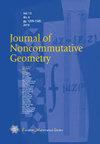Computing the spectral action for fuzzy geometries: from random noncommutative geometry to bi-tracial multimatrix models
IF 1
2区 数学
Q2 MATHEMATICS
引用次数: 10
Abstract
A fuzzy geometry is a certain type of spectral triple whose Dirac operator crucially turns out to be a finite matrix. This notion was introduced in [J. Barrett, J. Math. Phys. 56, 082301 (2015)] and accommodates familiar fuzzy spaces like spheres and tori. In the framework of random noncommutative geometry, we use Barrett's characterization of Dirac operators of fuzzy geometries in order to systematically compute the spectral action $S(D)= \mathrm{Tr} f(D)$ for $2n$-dimensional fuzzy geometries. In contrast to the original Chamseddine-Connes spectral action, we take a polynomial $f$ with $f(x)\to \infty$ as $ |x|\to\infty$ in order to obtain a well-defined path integral that can be stated as a random matrix model with action of the type $S(D)=N \cdot \mathrm{tr}\, F+\textstyle\sum_i \mathrm{tr}\,A_i \cdot \mathrm{tr} \,B_i $, being $F,A_i $ and $B_i $ noncommutative polynomials in $2^{2n-1}$ complex $N\times N$ matrices that parametrize the Dirac operator $D$. For arbitrary signature---thus for any admissible KO-dimension---formulas for 2-dimensional fuzzy geometries are given up to a sextic polynomial, and up to a quartic polynomial for 4-dimensional ones, with focus on the octo-matrix models for Lorentzian and Riemannian signatures. The noncommutative polynomials $F,A_i $ and $B_i$ are obtained via chord diagrams and satisfy: independence of $N$; self-adjointness of the main polynomial $F$ (modulo cyclic reordering of each monomial); also up to cyclicity, either self-adjointness or anti-self-adjointness of $A_i $ and $B_i $ simultaneously, for fixed $i$. Collectively, this favors a free probabilistic perspective for the large-$N$ limit we elaborate on.计算模糊几何的谱作用:从随机非交换几何到双迹多矩阵模型
模糊几何是一种特定类型的谱三元组,其Dirac算子是一个有限矩阵。这一概念在[J.Barrett,J.Math.Phys.56082301(2015)]中引入,并适用于熟悉的模糊空间,如球体和环面。在随机非交换几何的框架下,我们使用模糊几何的Dirac算子的Barrett特征来系统地计算$2n$维模糊几何的谱作用$s(D)=\mathrm{Tr}f(D)$。与最初的Chamseddine Connes谱作用相反,我们取一个多项式$f$,$f(x)\to\infty$为$|x|\to\infoty$,以获得一个定义良好的路径积分,该路径积分可以表示为一个随机矩阵模型,其作用类型为$S(D)=N\cdot\mathrm{tr}\,f+\textstyle\sum_i\mathrm{tr}\,a_i\cdot\math rm{tr}\,B_i$,为$f,参数化Dirac算子$D$的$2^{2n-1}$复矩阵$N\timesN$中的A_i$和$B_i$非对易多项式。对于任意签名——因此对于任何可容许的KO维数——给出了二维模糊几何的公式,直到六次多项式,直到四次多项式,重点讨论了洛伦兹和黎曼签名的八次矩阵模型。通过弦图得到了非交换多项式$F、A_i$和$B_i$,它们满足:$N$的独立性;主多项式$F$的自邻接性(每个单项的模循环重排序);对于固定的$i$,同时达到$A_i$和$B_i$的自邻接性或反自邻接性的循环性。总的来说,这有利于我们详细阐述的大-$N$极限的自由概率视角。
本文章由计算机程序翻译,如有差异,请以英文原文为准。
求助全文
约1分钟内获得全文
求助全文
来源期刊
CiteScore
1.60
自引率
11.10%
发文量
30
审稿时长
>12 weeks
期刊介绍:
The Journal of Noncommutative Geometry covers the noncommutative world in all its aspects. It is devoted to publication of research articles which represent major advances in the area of noncommutative geometry and its applications to other fields of mathematics and theoretical physics. Topics covered include in particular:
Hochschild and cyclic cohomology
K-theory and index theory
Measure theory and topology of noncommutative spaces, operator algebras
Spectral geometry of noncommutative spaces
Noncommutative algebraic geometry
Hopf algebras and quantum groups
Foliations, groupoids, stacks, gerbes
Deformations and quantization
Noncommutative spaces in number theory and arithmetic geometry
Noncommutative geometry in physics: QFT, renormalization, gauge theory, string theory, gravity, mirror symmetry, solid state physics, statistical mechanics.

 求助内容:
求助内容: 应助结果提醒方式:
应助结果提醒方式:


